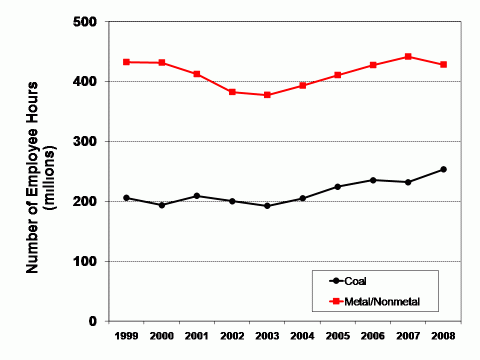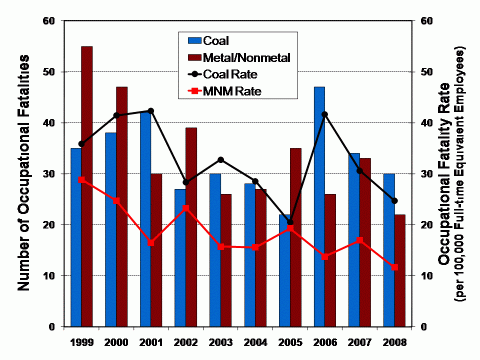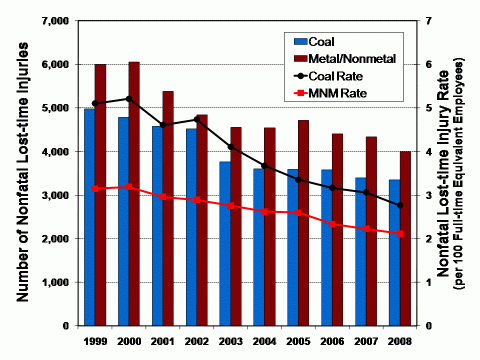Coal and Metal/Nonmetal Mining Facts - 2008 (HTML)
DHHS (NIOSH) Publication No. 2011-170
Mining Operations
Data obtained from the Mine Safety and Health Administration (MSHA) indicated 2,129 active coal (14.3%) and 12,778 metal/nonmetal (85.7%) mining operations. [1]
- There were 26 states reporting coal mining operations. Approximately 73% of these mines were located in three states: Kentucky (n=656; 38.0%), West Virginia (n=479; 22.5%), and Pennsylvania (n=425; 20.0%).
- Metal/nonmetal mines were distributed across all states, Puerto Rico, and the Virgin Islands. Texas reported the most metal/nonmetal mines (n=725, 5.7%).
Companies
In 2008, independent contracting companies reported employment at 3,467 coal mines and 6,128 metal/nonmetal mines.
Employees
A total of 133,827 mine operator and independent contractor employees, [2] or 126,500 full-time equivalent (FTE) [3] employees, were reported to MSHA as working at coal mines. This is on contrast to 258,892 employees (or 214,120 FTE employees) who were reported as working at metal/nonmetal mines.
| Commodity and Type of Employer | 1999 | 2000 | 2001 | 2002 | 2003 | 2004 | 2005 | 2006 | 2007 | 2008 |
|---|---|---|---|---|---|---|---|---|---|---|
| Coal Operator | 205.7 | 193.5 | 208.8 | 200.4 | 192.1 | 205.0 | 224.3 | 235.1 | 232.0 | 253.0 |
| Metal/Nonmetal Operator | 432.4 | 431.4 | 412.2 | 382.3 | 377.1 | 393.2 | 410.7 | 427.4 | 441.5 | 428.2 |
Fatalities
Of the 52 occupational mining fatalities reported to MSHA in 2008, 30 occurred at coal mining operations, while 22 occurred at metal/nonmetal mines.
- The fatality rate of 24.8 [95% confidence interval (CI): 16.7, 35.3] per 100,000 FTE employees was higher at coal mining operations, compared to the rate of 11.6 [CI: 7.3, 17.6] for metal/nonmetal mines.
| Commodity and Type of Employer | 1999 | 2000 | 2001 | 2002 | 2003 | 2004 | 2005 | 2006 | 2007 | 2008 |
|---|---|---|---|---|---|---|---|---|---|---|
| Coal Operator | 35 | 38 | 42 | 27 | 30 | 28 | 22 | 47 | 34 | 30 |
| Metal/Nonmetal Operator | 55 | 47 | 30 | 39 | 26 | 27 | 35 | 26 | 33 | 22 |
| Coal Rate | 35.8 | 41.4 | 42.3 | 28.3 | 32.8 | 28.6 | 20.5 | 41.6 | 30.6 | 24.8 |
| Metal/Nonmetal Rate | 28.8 | 24.7 | 16.5 | 23.3 | 15.7 | 15.6 | 19.3 | 13.8 | 16.9 | 11.6 |
Nonfatal Lost-time Injuries
There were 3,352 nonfatal lost-time injuries reported at coal mining operations, resulting in 195,120 days lost from work. [4] This compares to 3,996 nonfatal lost-time injuries attributed to metal/nonmetal mine workers with 187,090 days lost from work.
- The coal mine nonfatal lost-time injury rate was greater than the metal/nonmetal mine rate (2.8 [CI: 2.7, 2.9] vs. 2.1 [CI: 2.1, 2.2] per 100 FTE workers).
- The most frequent accident classification of nonfatal lost-time injuries involved handling materials for both coal (n=947; 28.3%) and metal/nonmetal mines (n=1,353; 33.9%).
- Sprains and strains were the most frequently reported nature of injury for both coal (n=1,390; 41.5%) and metal/nonmetal (n=1,777; 44.5%) mining operations.
| Commodity and Type of Employer | 1999 | 2000 | 2001 | 2002 | 2003 | 2004 | 2005 | 2006 | 2007 | 2008 |
|---|---|---|---|---|---|---|---|---|---|---|
| Coal Operator | 4,983 | 4,781 | 4,572 | 4,518 | 3,763 | 3,601 | 3,597 | 3,578 | 3,402 | 3,352 |
| Metal/Nonmetal Operator | 6,001 | 6,058 | 5,377 | 4,840 | 4,559 | 4,538 | 4,713 | 4,410 | 4,340 | 3,996 |
| Coal Rate | 5.1 | 5.2 | 4.6 | 4.7 | 4.1 | 3.7 | 3.4 | 3.2 | 3.1 | 2.8 |
| Metal/Nonmetal Rate | 3.1 | 3.2 | 3.0 | 2.9 | 2.8 | 2.6 | 2.6 | 2.3 | 2.2 | 2.1 |
Mining operations, 2008
| Commodity and Type of Employer | Underground Mining Operations [1] | Surface Mining Operations [1] | Total Mining Operations [1] |
|---|---|---|---|
| Coal Operator | 665 | 1,464 | 2,129 |
| Coal Contractor | Not applicable | Not applicable | Not applicable |
| Coal Total | 665 | 1,464 | 2,129 |
| Metal/Nonmetal Operator | 260 | 12,518 | 12,778 |
| Metal/Nonmetal Contractor | Not applicable | Not applicable | Not applicable |
| Metal/Nonmetal Total | 260 | 12,518 | 12,778 |
| Total | 925 | 13,982 | 14,907 |
Employment characteristics, 2008
| Commodity and Type of Employer | Underground Employees [2] | Surface Employees [2] | Total Employees [2] | Underground FTE Employees [3] | Surface FTE Employees [3] | Total FTE Employees [3] |
|---|---|---|---|---|---|---|
| Coal Operator | 40,370 | 49,685 | 90,055 | 45,866 | 54,312 | 100,178 |
| Coal Contractor | 6,262 | 37,510 | 43,772 | 4,105 | 22,216 | 26,321 |
| Coal Total | 46,632 | 87,195 | 133,827 | 49,971 | 76,528 | 126,500 |
| Metal/Nonmetal Operator | 10,298 | 173,143 | 183,441 | 10,596 | 163,438 | 174,034 |
| Metal/Nonmetal Contractor | 2,992 | 72,459 | 75,451 | 1,998 | 38,088 | 40,086 |
| Metal/Nonmetal Total | 13,290 | 245,602 | 258,892 | 12,594 | 201,526 | 214,120 |
| Total | 59,922 | 332,797 | 392,719 | 62,565 | 278,054 | 340,620 |
Mining Occupational Fatalities (per 100,000 FTE employees), 2008
| Commodity and Type of Employer | Underground Injuries | Underground Injury Rate | Surface Injuries | Surface Injury Rate | Total Injuries | Total Injury Rate |
|---|---|---|---|---|---|---|
| Coal Operator | 2,103 | 4.6 | 768 | 1.5 | 2,871 | 3.0 |
| Coal Contractor | 168 | 4.1 | 313 | 1.5 | 481 | 1.9 |
| Coal Total | 2,271 | 4.5 | 1,081 | 1.5 | 3,352 | 2.8 |
| Metal/Nonmetal Operator | 291 | 2.7 | 3,204 | 2.3 | 3,495 | 2.3 |
| Metal/Nonmetal Contractor | 38 | 1.9 | 463 | 1.3 | 501 | 1.3 |
| Metal/Nonmetal Total | 329 | 2.6 | 3,667 | 2.1 | 3,996 | 2.1 |
| Total | 2,600 | 4.2 | 4,748 | 1.9 | 7,348 | 2.4 |
Not calculated when N is less than 5. 95% CI for rates reported above. Totals may not sum due to independent rounding.
Data source: Publicly released employment and accident/injury/illness data collected by MSHA under 30 CFR 50.
Notes: All analyses of accident data exclude office employees. Occupational fatalities exclude all cases under 17 years of age. Further statistical methodology is available on the NIOSH Internet. Caution should be used when interpreting rates based on a small number of events.
- Mines at which only independent contractors were working did not show any employment and were not counted. The metal/nonmetal mining classification includes metal, nonmetal, stone, and sand and gravel mining sectors.
- Average number of employees working at individual mines during calendar quarters of active operations (includes office workers).
- Full-time equivalent employees computed using reported employee hours (2,000 hours = 1 FTE).
- Includes actual days away from work and/or days of restricted work activity. For permanently disabling injuries only, statutory days charged by MSHA were used if they exceeded the total lost workdays.
To receive NIOSH documents or more information about occupational safety and health topics, contact NIOSH at 1-800-CDC-INFO (1-800-232-4636), TTY: 1-888-232-6348, e-mail: cdcinfo@cdc.gov, or visit the NIOSH Web site.
See Also
- Coal Operator Mining Facts - 2005
- Metal Operator Mining Facts - 2002
- Metal Operator Mining Facts - 2004
- Metal Operator Mining Facts - 2005
- Noncoal Contractor Mining Facts - 2003
- Nonmetal Operator Mining Facts - 2002
- Nonmetal Operator Mining Facts - 2008
- Sand and Gravel Operator Mining Facts - 2006
- Stone Operator Mining Facts - 2003
- Stone Operator Mining Facts - 2005
- Page last reviewed: 3/2/2015
- Page last updated: 3/26/2014
- Content source: National Institute for Occupational Safety and Health, Mining Program


 ShareCompartir
ShareCompartir


